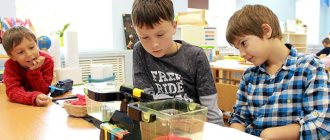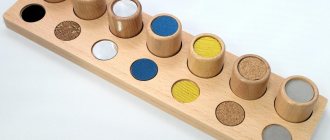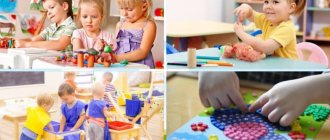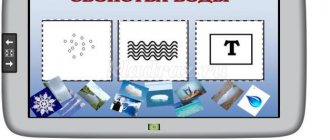Montessori materials
Today, the effectiveness of the Montessori method of developing and teaching children is beyond doubt.
Observing the games of children and their natural development, the famous scientist and philosopher Maria Montessori created a unique system of raising children, based on the idea of motivating a child for self-development and self-knowledge. Each baby is unique and from birth strives for independence, and the task of adults is to help him discover his capabilities - the scheme of work with children in Montessori schools - schools that follow the methodology of the greatest humanist teacher - is built on this principle. In addition, educational institutions of this type use didactic material developed by the creator herself and intended for the development of fine motor skills and sensory skills of children.
Montessori didactic material
Maria Montessori's catalog of games and manuals is quite diverse. After all, the teacher dedicated her entire life to teaching children, and through trial and error she selected only the best and most effective exercises, games and materials. She took into account every detail. The comfort of the furniture, the proper organization of space, the observance of rules and order, the age of the children - not a single smallest detail was left without her attention.
What can we say about the “golden material of Montessori” - games and didactic educational materials that are used by supporters of the method to this day. Modern toys are created on their basis, and handicraft mothers make analogues for their children with their own hands. For example, modern puzzles, sorters, educational rugs - all this is the legacy of Maria Montessori. They contribute to the development of personality, help to independently explore the world around us, as well as systematize already acquired skills and knowledge. Focusing on the development of fine motor skills and sensory skills, the creator sought to develop the spirituality of children, because in her opinion, this is the basis of a full-fledged, free and self-sufficient personality.
To have a clearer idea of the materials for Montessori classes, let's look at a few examples:
- Various bags with filling. Cereals, peas, beans, and polystyrene foam are used as the latter. Their task is to develop the tactile and visual abilities of children.
- Jars with different fillings. Develops the hearing abilities of the little ones.
- A chest of secrets will surely appeal to older children. A simple device in the form of a box with various jars, each containing a surprise (for example, a small toy), will teach your baby how to open and close containers, and will also help develop his hands.
- Plastic “hungry” toys with a hole in the mouth. Of course, the baby will not refuse to help his “friend” and will gladly feed him small beads or peas. This exercise trains the eye, hand, attention and patience.
- Finger paints are a brilliant invention; many children really like them. Well, drawing itself is undoubtedly a fascinating and useful activity for children of all age categories.
- Cut pictures are a kind of mini-puzzles.
- Objects of a certain group that differ in color, shape or size. For example, three Christmas trees are laid out in front of the child and mixed circles are given: red, blue and yellow. The child’s task is to decorate each Christmas tree with circles of a certain color.
- Insert frames. Created like a simple construction set, usually wooden, they train optical-spatial thinking, fine motor skills and coordination. There are various inserts with images of animals, cartoon characters, vegetables and fruits, and geometric shapes.
- Pink Tower. Introduces children to the concepts of “big” and “small”, “less”, more.
Freedom of the child and the role of the educator
By the role of a teacher we will understand not only employees of child care institutions, but also the child’s parents and other adults who decided to use this method.
Montessori invites the teacher to master the consciousness of a scientist. Take on a more specialized role as an observer of the child (like a scientist in a laboratory observing microorganisms through a microscope) rather than simply monitoring his safety and assigning tasks.
“I firmly believe that we should cultivate in our teachers the spirit of a scientist, and not instill in them the skills of mechanical work.”
The teacher's task is to meaningfully monitor the child. The teacher should not impose knowledge or purposefully teach the child. He can sometimes only slightly direct the child’s actions (without nevertheless allowing him to feel his presence). And he can help only at the request of the child himself.
"Wait and watch." This is the motto of the teacher. Let's wait and be always ready to share with the child his successes and difficulties. He himself will ask us for help, and then we will have to respond joyfully. Let us be patient as we watch his slow progress. And we will show joy and enthusiasm when the child wants to share his successes with us. If we could say, “We have respect and interest in the actions of our children, we treat them as we would like to be treated,” then we would certainly understand the great principle of education and would undoubtedly become a model good teachers."
The child himself is given the task of being free and doing whatever he wants in the environment, without disturbing other children. But even so, the teacher should not be a passive observer, but should be an active scientist:
“The freedom of the child must have a limitation, the criterion of which is the collective and its interests, and a form that is commonly called good upbringing. To do this, you need to study each child individually, finding out what in his behavior can cause offense and irritation to others, and what inclinations can subsequently lead to rude behavior. In all other respects - in all manifestations that have some benefit - whatever they may be and whatever form they are expressed in - everything should be allowed, but with mandatory supervision from the teacher.”
In such a free environment, the child learns and develops independently, through Montessori materials (parents call them “Montessori toys”), which contain self-learning functions.
The classic Montessori group consists of children from 2 years 8 months to 6 years. All children study in the same group, not separated by age. This is a good solution, since the younger ones learn from the older ones, take from them examples of behavior, actions with objects, etc.; and the elders learn to teach the younger ones, showing sensitivity and care, they take on the role of leader and mentor. This interaction helps establish a friendly atmosphere in the group.
Matching games
Matching games are the most popular Montessori activities for ages 1 to 3. The main types are:
- Activities with colors - you can offer your child a cardboard circle with multi-colored sectors and clothespins of the same shades. The child must independently choose his own clothespin for each sector.
- The game can be combined with the help of mom. For example, invite your child to sort washed socks into pairs.
How children dance in kindergarten in a playful way and with an accelerated tempo
This group of classes develops logic and attention.
Games with colors
Pros and cons of the technique
When considering the Montessori method, there are several main disadvantages that critics mention:
- After learning under this system, it may be difficult for a child to fit into the school community and follow the rules. This is due to the fact that the Montessori method implies free movement around the classroom and independent choice of activities.
- Groups of different ages. According to educators who criticize Montessori theory, elders will always dominate and suppress younger ones who interfere with them.
- Refusal of fairy tales and poems. Maria Montessori considered fairy tales useless, since they only teach to escape from reality into fantasy.
- Distraction from social reality. Kindergarten students learn to do what they want and some of them rarely work in a team. Moreover, the methodology involves the use of too many objects that create an artificial environment, which is why adaptation problems may arise when studying in primary school.
Note! But the advantages can overshadow the disadvantages of the system. The main advantage is that the child gets used to learning independently and constantly strives for development. In this case, the child is not criticized, and punishments are completely excluded. The Montessori method teaches order and respect for others from early childhood.
Lesson in a Montessori classroom
Another advantage of the system is that students begin to write and read earlier. At the same time, teachers apply an individual approach to each child, taking into account his abilities and needs.
Interesting! To work with this system, a teacher can take a short training course.
Another advantage is the formation of groups not by age, but by interests. This increases interest in the learning process itself. The technique also implies the development of independence and the ability to make decisions. Despite all the pros and cons of the Montessori system, this approach encourages students to engage in self-development of their own free will, and not under compulsion.
Open mathematical classes in secondary groups according to the Federal State Educational Standard
Montessori games for early development: small objects
Transferring small objects (coins, beads, pebbles) from one vessel to another using tongs or a spatula is a rather difficult task for small fingers. But it develops the child’s fine motor skills well.
How to teach your child to divide and multiply numbers
Beans, buckwheat, rice and other cereals are also good for playing with small objects.
Sensory development
Games based on the Montessori method for sensory development
Sensory activities are very exciting for the kids. One of these games is a bag, in which they must identify the object by touch. This causes great delight in the kids as soon as they guess.
For Montessori games, DIY materials may include making sound cylinders. They are made from any containers or boxes that can be filled with cereals, pebbles, and coins. Such items develop hearing acuity in children.
Note! Finger painting is considered one of the most exciting activities. During its implementation, the baby can develop fine motor skills, imagination and curiosity.
Fun drawing
Sent for sorting
Games focused on the sorting principle are aimed at developing visual skills and help train other organs. As a game activity you can offer:
- Sorting items from 2 to 5 years old. It can be both in shape and color. The lesson develops attentiveness and logic. For the activity you need to take several sets of objects according to size, shape and color. Playing with buttons has a good effect on development. You need to take a large number of buttons, in which there will be five or six identical ones. Mix all the buttons in a bowl, then show your child which type to choose.
- An excellent activity for sensory development is wooden cubes of various sizes. You can buy cubes that are inserted into each other, like a nesting doll.
- A pyramid would be a good activity for children aged two years and older. It can be of any type, but the principle is the same. Such a toy should have one rod and a set of elements. The child's task is to find identical shapes, for example, circles.
- You can choose simple puzzles as a sorting game. In the Montessori method, wooden ones with beautiful pictures are selected. For children under four years old, you should choose puzzles in which each element has a handle to make it easy to hold. It is recommended to avoid cardboard frames.
Pyramid game
Hygiene
Much attention in Montessori pedagogy is paid to hygiene. This is due to the fact that “Children’s Houses” (kindergarten for residents of apartment buildings) were opened, although in rebuilt, but in the poorest areas of Rome, where the low strata of society lived, crime, debauchery and violence reigned, and in an apartment they could live up to 20-30 people and there was water only a few hours a day. In his main book, “My Method,” Montessori describes these areas at length, but we will limit ourselves to just one phrase:
“Where in the dark no one risks going out without a weapon.”
In such an area, after some “renovation”, the first “Children’s Home” opened. When organizing it, the issue of hygiene became a big problem. Therefore, the first and main rule of this institution was:
“Mothers are obliged to send their children to the orphanage clean.”
Thus, due to social problems, one of the main provisions of Montessori pedagogy appeared.
From the first visit to kindergarten, a child learns to wash his hands and clean his nails, clean up after himself, etc. All this leads to the fact that the child monitors his appearance, actions in every possible way and tries to behave carefully.
Montessori method - for which children is this approach suitable?
Surprisingly, we often meet parents who are convinced that Montessori teaching methods are only suitable for gifted and “naturally” motivated children. Parents feel that if their son or daughter is not forced to study, they will simply lie on the couch all day.
In fact, it is always worth remembering that children’s curiosity and desire to explore the world are an innate quality of absolutely any child. The described passivity is most often caused by external factors: an unsuitable environment and an incorrectly organized daily routine, incorrect behavior of adults, and poor health of the child.
Despite the fact that all Montessori techniques involve the child’s free choice and almost unlimited movement around the classroom, even the most “uncontrollable” and “difficult” children eventually successfully integrate into the process.
However, if you think that at first it will be difficult for your baby in group classes using the Montessori method or you are worried about some of the child’s health, all branches of our club offer individual lessons so that your baby has additional adult attention for easier adaptation to a new environment.
The main directions of child development in the Montessori system
Montessori games are aimed at the widespread use of all components of children's life.
The most important of them:
- Practice. Knowledge, experience, skills and abilities are acquired only through persistent practical training.
- Sensory perception. The world around us is known through the senses. They need to be developed.
- Mental exercises. Mathematics is the fundamental basis for all other sciences.
- Communication, language, verbal contacts. Socialization begins with them.
- Space. Children's abilities should “work” towards acquiring future professions.
Note. The last point of the program includes classes in applied sciences such as physics, chemistry, and biology. Games are also widely used to develop skills in drawing, music and languages. Parents can make their own manuals.





